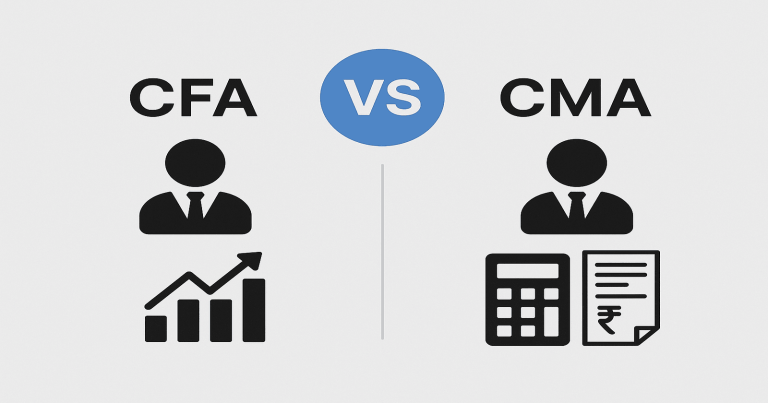Choosing between CMA or CFA is one of the most important decisions for finance and commerce students, especially in India. Both are globally recognized qualifications. Both offer rewarding career opportunities, yet they lead to different career paths. The key difference lies in their focus areas. CMA, or Certified Management Accountant, deals with cost management, budgeting, and business decision-making. On the other hand, CFA, or Chartered Financial Analyst, focuses on investment analysis, portfolio management, and equity research. So, when a student or professional asks, “Should I do CMA or CFA?” The real answer depends on what they want to do in their career.
CMA is the preferred choice, if you are interested in corporate finance, internal audit, management accounting, and business strategy. It prepares you for roles within organizations, helping them plan budgets, control costs, and make better financial decisions. But if you are more interested in stock markets, wealth management, financial analysis, and investment banking, then CFA is the perfect path. CFA is considered the gold standard in investment and finance-related roles. It gives deep knowledge of financial modelling, ethics, and quantitative methods.
CMA or CFA : Key Differences
Understanding the core differences between CMA and CFA is crucial for choosing the right career path in finance. While both are globally recognized, they serve different professional goals. The following table highlights the key factors like duration, cost, job roles, and salary.
| Criteria | CMA (Certified Management Accountant) | CFA (Chartered Financial Analyst) |
| Full Form | Certified Management Accountant | Chartered Financial Analyst |
| Governing Body | Institute of Management Accountants (IMA), USA | CFA Institute, USA |
| Exam Levels/Parts | 2 Parts | 3 Levels (Level I, II, III) |
| Course Duration | 12–18 Months | 2–3 Years |
| Eligibility | 12th + Bachelor’s Degree (can start during degree) | Bachelor’s Degree (or final year of degree) |
| Cost in India | ₹1.5–₹2.5 Lakhs | ₹2.5–₹3.5 Lakhs |
| Pass Percentage | 45%–50% | 35% (Level I), 45% (Level II), 50% (Level III) |
| Focus Areas | Cost Accounting, Budgeting, Performance, Strategy | Investment Analysis, Portfolio Management, Ethics |
| Exam Frequency | 3 Testing Windows per year | Feb, May, Aug, Nov (varies per level) |
| Exam Mode | Online (Prometric Centers) | Online (Pearson VUE centers) |
| Work Experience Needed | 2 Years in Management Accounting Role | 4 Years in Investment-related Roles |
| Typical Job Roles | Cost Accountant, Financial Analyst, Finance Manager | Investment Analyst, Portfolio Manager, Equity Researcher |
| Top Employers | MNCs, Corporate Finance Departments | Investment Banks, Mutual Funds, Hedge Funds |
| Global Recognition | High in Management & Accounting Fields | Very High in Finance & Investment Fields |
| Salary Range in India | ₹6–₹15 LPA | ₹7–₹25 LPA |
| Best For | Corporate Finance, Internal Strategy | Equity Markets, Financial Analysis |
| Difficulty Level | Moderate | High |
What is CMA and CFA?
Before diving deep into comparisons, we need to understand what CMA and CFA are. These are both professional certifications, but they focus on entirely different skill sets and career paths.
CMA: Certified Management Accountant
CMA is a globally recognized certification awarded by the Institute of Management Accountants (IMA), USA. It focuses on skills required for internal financial management in companies. The course content teaches how to analyze and control costs, design financial strategies, and support business growth through data-driven decisions. It is popular among students who aim to work in financial planning, business analysis, and strategic management within companies.
The CMA course is divided into two parts. Each part includes six major topics. These parts test your understanding of cost planning, risk management, internal controls, and decision analysis. The exam format includes multiple-choice questions and essay questions. The content is highly practical and directly related to real-life work in companies.
CFA: Chartered Financial Analyst
The CFA Program is a professional credential offered by the CFA Institute, USA. It focuses mainly on investment management and financial analysis. It is considered the most respected qualification for those entering investment banking, equity research, and portfolio management. The CFA program provides in-depth training in areas like corporate finance, economics, financial reporting, derivatives, alternative investments, and ethics.
The CFA program consists of three levels: Level I, Level II, and Level III. Each level gets tougher and goes deeper into financial concepts. The program is designed to build a strong foundation in finance and grow into advanced portfolio and wealth management strategies. Passing all three levels and completing relevant work experience qualifies you to become a CFA charter holder.
Course Structure and Duration
Choosing between CMA or CFA becomes easier when you understand how both programs are structured and how long they take to complete. Many Indian students decide based on how fast they can finish and start working. Others choose based on how deeply the program teaches them the subjects they love. The structure of the course and the time it takes to complete it are important factors to consider when choosing between CMA or CFA.
CMA Course Structure
The CMA USA program has two parts:
- Part 1: Financial Planning, Performance, and Analytics
- Part 2: Strategic Financial Management
Each part includes multiple topics like budgeting, performance evaluation, cost management, internal control, investment decisions, and professional ethics. Candidates can appear for the exams in three testing windows each year: January/February, May/June, and September/October.
Each exam part is four hours long, with 100 multiple-choice questions and two essay-type scenarios. On average, students complete the entire CMA certification within 6 to 12 months. You can also start your CMA studies during graduation and complete it soon after.
CFA Course Structure
The CFA Program is divided into three levels:
- Level I: Introduces basic concepts like financial tools, ethical standards, and quantitative methods.
- Level II: Focuses on asset valuation, company analysis, and financial reporting
- Level III: Covers portfolio management, wealth planning, and applying ethical principles in complex scenarios.
CFA exams are held twice a year for Level I and Level II and once for Level III. The exams are computer-based and last over 4.5 hours each. The entire program takes about 2.5 to 3 years for most candidates. Due to the depth of the content and the analytical nature of the exam, CFA requires a much higher study commitment, with around 300+ hours recommended per level.
Eligibility and Entry Requirements
Understanding the eligibility for each course helps you plan your education and career timeline better. Before you choose between CMA or CFA, you must know if you are eligible to register for the course. This is the first step in your journey, and it helps you plan your education timeline correctly. Both the CMA and CFA programs are professional certifications offered by top global bodies—the Institute of Management Accountants (IMA) and the CFA Institute, respectively. But the entry rules for both are quite different.
CMA Eligibility
To become a CMA, candidates must have following eligibility:
- A bachelor’s degree in any field from an accredited university.
- Two years of relevant work experience in finance or accounting.
- Active membership with the IMA.
However, students can begin studying for the CMA exams even while pursuing their graduation. The only requirement is that they complete the degree and experience criteria before applying for the CMA certificate.
CFA Eligibility
To appear for the CFA Level I exam, candidates must:
- Be in the final year of their bachelor’s degree or have already completed it.
- Have four years of professional work experience (not necessarily in finance) or a combination of work and education that totals four years.
After passing all three levels, candidates must also gain at least four years of investment-related work experience to receive the CFA charter.
Subjects and Syllabus
Looking at what subjects are taught gives you a better idea of what to expect and which course suits your strengths. Before choosing between CMA or CFA, you should carefully look at what you will study in each course. The subjects and syllabus are not just academic topics; they shape your skills, thinking style, and job role in the future. Many students ignore this step and later feel stuck in a course that doesn’t match their interests.
If you want a career in business finance, planning, and decision-making, CMA gives you more practical subjects in accounting and control. If you want to work in investments, equity research, or asset management, CFA gives you deeper topics in financial analysis, valuation, and markets. Let’s explore the syllabus of both programs one by one to help you understand what you will actually study.
CMA Subjects
The CMA syllabus focuses more on cost and management accounting and includes the following topics:
- Budgeting and Forecasting
- Performance Management
- Cost Management
- Internal Controls
- Financial Statement Analysis
- Investment Decisions
- Professional Ethics
These topics are designed to help you in internal business roles where you must make data-backed decisions. The CMA syllabus is highly practical and can be used directly in businesses’ day-to-day operations.
CFA Subjects
The CFA syllabus is deeper and more analytical, with focus areas such as:
- Financial Reporting and Analysis
- Equity Investments
- Fixed Income
- Portfolio Management
- Quantitative Methods
- Economics
- Corporate Finance
- Derivatives
- Alternative Investments
- Ethical and Professional Standards
This course is meant for those who want to enter the finance industry, especially in roles dealing with market research, investment management, and client portfolios. The depth of topics requires strong analytical and mathematical skills.
Career Scope and Opportunities
Understanding the career scope of CMA or CFA is one of the most important steps in choosing the right course for your future. Both certifications offer strong job prospects, but they lead to different kinds of roles in the finance world. CMA prepares you for internal business roles like budgeting, cost analysis, and corporate decision-making. These positions are often found in multinational companies, manufacturing firms, and consulting services. On the other hand, CFA opens doors to the investment and financial markets sector. You can work with mutual funds, hedge funds, banks, and financial advisory firms. Your daily tasks in CFA-based roles may include analyzing financial data, valuing companies, or managing investment portfolios. Knowing what kind of companies hire CMAs and CFAs and what roles they offer helps you align your goals clearly.
Career After CMA
CMA holders usually work in internal finance departments. Their focus is on reducing costs, improving efficiency, and helping business leaders make decisions. Common job roles for CMA professionals include:
- Cost Accountant
- Budget Analyst
- Internal Auditor
- Financial Analyst
- Business Controller
- Corporate Finance Manager
CMA is valuable in industries like manufacturing, retail, FMCG, healthcare, and consulting, where cost control and strategic planning are important.
Career After CFA
CFA charter holders usually work in investment firms, banks, mutual funds, or private equity. Their job is to manage money, advise clients, or analyze investments. Common roles for CFA professionals include:
- Investment Banker
- Equity Research Analyst
- Portfolio Manager
- Risk Analyst
- Financial Advisor
- Wealth Manager
CFA is highly respected in finance and capital markets. If you want to work in the stock market or global finance, CFA is the better choice.
Salary Potential in India
When choosing between CMA or CFA, one major factor Indian students and professionals consider is the salary potential. Both CMA and CFA offer high-paying opportunities, but the earning power depends on several factors, such as the level of qualification, experience, job location, and the industry you work in. CMA professionals usually start their careers in internal finance roles such as cost control, budgeting, and corporate accounting. These roles pay well and grow steadily with experience, especially in sectors like manufacturing, FMCG, and IT services. CFA professionals, on the other hand, work in fields like investment banking, asset management, research, and portfolio advisory—fields that often offer higher starting salaries, especially in metros and global firms.
CMA Salaries
CMA professionals earn good salaries in India, especially in MNCs and large companies.
- Entry-level (0–2 years): ₹4–6 LPA
- Mid-level (3–7 years): ₹8–12 LPA
- Senior-level (10+ years): ₹15–20+ LPA
CFA Salaries
CFA salaries tend to be higher, especially in finance and investment roles.
- Entry-level (0–2 years): ₹6–8 LPA (Level I/II)
- CFA Charterholder: ₹10–20 LPA
- Senior roles (with experience): ₹30+ LPA
Salaries vary based on company, city, skillset, and experience. CFA often pays more but takes longer to complete and requires more experience.
Final Verdict: Which One Should You Choose?
The choice between CMA or CFA should depend on your interests, skills, and career goals.
- Choose CMA if you like planning, budgeting, cost control, and working with internal teams in companies. It is quicker to complete and suits those aiming for corporate finance roles.
- Choose CFA if you love finance, stock markets, investments, and analysis. It takes longer but opens up high-paying roles in investment banking and asset management.
Both are respected certifications. But their purpose is different. Look at where you see yourself in 5 to 10 years. That vision will help you choose the right path.


